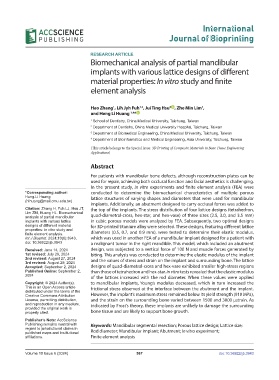Page 575 - IJB-10-6
P. 575
International
Journal of Bioprinting
RESEARCH ARTICLE
Biomechanical analysis of partial mandibular
implants with various lattice designs of different
material properties: In vitro study and finite
element analysis
Hao Zhang , Lih Jyh Fuh , Jui Ting Hsu 3 id , Zhe Min Lim ,
1,2
1
1
and Heng Li Huang *
1,4 id
1 School of Dentistry, China Medical University, Taichung, Taiwan
2 Department of Dentistry, China Medical University Hospital, Taichung, Taiwan
3 Department of Biomedical Engineering, China Medical University, Taichung, Taiwan
4 Department of Bioinformatics and Medical Engineering, Asia University, Taichung, Taiwan
(This article belongs to the Special Issue: 3D Printing of Composite Materials in Bone Tissue Engineering
Applications)
Abstract
For patients with mandibular bone defects, although reconstruction plates can be
used for repair, achieving both occlusal function and facial aesthetics is challenging.
In the present study, in vitro experiments and finite element analysis (FEA) were
*Corresponding author: conducted to determine the biomechanical characteristics of multiple porous
Heng-Li Huang lattice structures of varying shapes and diameters that were used for mandibular
(hlhuang@mail.cmu.edu.tw)
implants. Additionally, an abutment designed to carry occlusal forces was added to
Citation: Zhang H, Fuh LJ, Hsu JT, the top of the implants. The stress distribution of four lattice designs (tetrahedron,
Lim ZM, Huang HL. Biomechanical
analysis of partial mandibular quad-diametral-cross, hex-star, and hex-vase) of three sizes (2.5, 3.0, and 3.5 mm)
implants with various lattice in cubic porous models were analyzed by FEA. Subsequently, two optimal designs
designs of different material for 3D-printed titanium alloy were selected. These designs, featuring different lattice
properties: In vitro study and
finite element analysis. diameters (0.5, 0.7, and 0.9 mm), were tested to determine their elastic modulus,
Int J Bioprint. 2024;10(6):3943. which was used in another FEA of a mandibular implant designed for a patient with
doi: 10.36922/ijb.3943 a malignant tumor in the right mandible. This model, which included an abutment
Received: June 14, 2024 design, was subjected to a vertical force of 100 N and muscle forces generated by
1st revised: July 29, 2024 biting. This analysis was conducted to determine the elastic modulus of the implant
2nd revised: August 27, 2024 and the values of stress and strain on the implant and surrounding bone. The lattice
3rd revised: August 29, 2024
Accepted: September 2, 2024 designs of quad-diametral-cross and hex-vase exhibited smaller high-stress regions
Published Online: September 2, than those of tetrahedron and hex-star. In vitro tests revealed that the elastic modulus
2024 of the lattices increased with the rod diameter. When these values were applied
Copyright: © 2024 Author(s). to mandibular implants, Young’s modulus decreased, which in turn increased the
This is an Open Access article frictional stress observed at the interface between the abutment and the implant.
distributed under the terms of the
Creative Commons Attribution However, the implant’s maximum stress remained below its yield strength (910 MPa),
License, permitting distribution, and the strain on the surrounding bone varied between 1500 and 3000 µstrain. As
and reproduction in any medium, indicated by Frost’s theory, these implants are unlikely to damage the surrounding
provided the original work is
properly cited. bone tissue and are likely to support bone growth.
Publisher’s Note: AccScience
Publishing remains neutral with Keywords: Mandibular segmental resection; Porous lattice design; Lattice size;
regard to jurisdictional claims in
published maps and institutional Rod diameter; Mandibular implant; Abutment; In vitro experiment;
affiliations. Finite element analysis
Volume 10 Issue 6 (2024) 567 doi: 10.36922/ijb.3943

